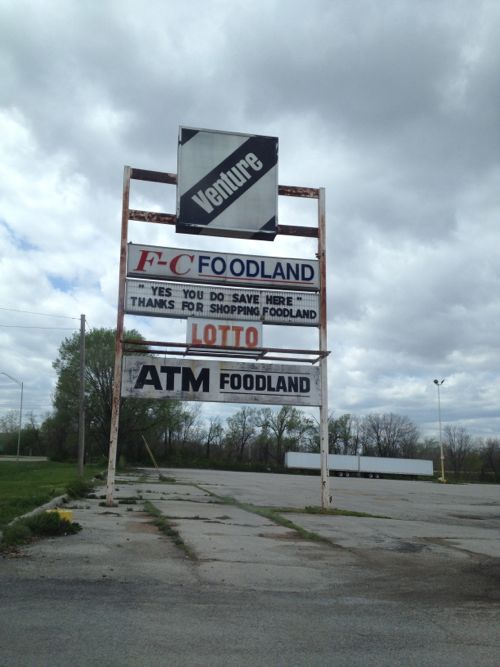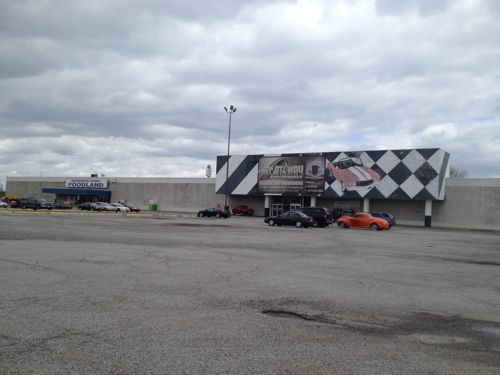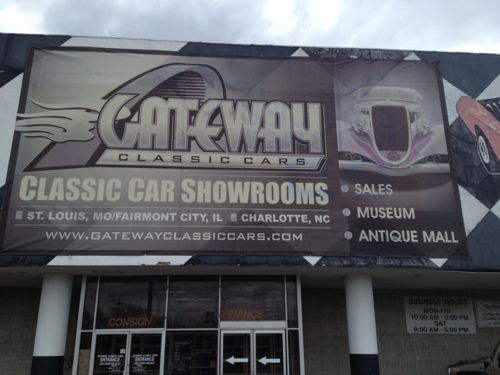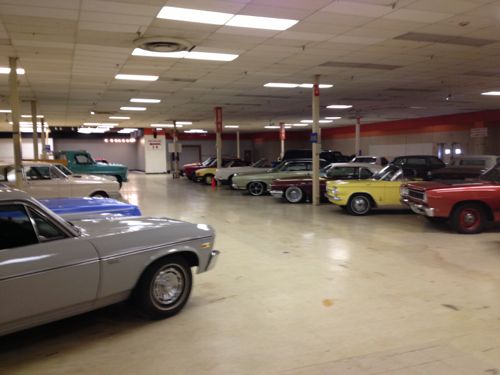Old Big Box Stores Live On, Some Too Long
It has been 15 years since St. Louis-based Venture stores closed.
The chain was founded in 1968 when Target founder John F. Geisse went to work for May Department Stores. Under an antitrust settlement reached with the Department of Justice, May was unable to acquire any more retail chains at the time, and the department store company needed a way to compete against the emerging discount store chains. When May’s Executive Vice President Dave Babcock learned that Geisse had resigned from Target Stores, he spoke with Geisse about starting a new discount retailer, resulting in the founding of Venture.
The first Venture store opened in 1970 in the St. Louis suburb of Overland (after Venture closed, the location became a Kmart, which later closed & was demolished for the current Home Depot). In 1976, Geisse retired and left Venture Stores, which had by that time expanded to 20 units. (Wikipedia)
When I was a kid, following the failure of the Woolco discount chain, Venture expanded into Oklahoma City (source). A Woolco/Venture was very close to my parent’s house, I biked there often to buy 45s & later cassingles.
Last week, as I stepped into a former Venture store at 5401 Collinsville Rd in Fairmont City, IL, I recalled biking to Venture as a kid and even visiting a Venture after moving to St. Louis.




When a building gets built we should assume it’ll be around for at least half a century. Often this longevity is a good thing, but not always. I took a picture of the men’s restroom but I decided to spare you that sight.
Older structures do provide good low-rent options for businesses, while not making a positive contribution to the area’s image. This is a good example of why we need to think beyond the original depreciation schedule when building.
— Steve Patterson
Venture was my mom’s favorite retailer when I was a kid and I remember going to the one on Kirkwood road all the time. Now it’s a Hobby Lobby or something.
This is an important reminder of how bad buildings stick around and why it’s best to stop them in the first place. There are very few uses for them except as giant retailers. The classic cat museum was a good one.
Not every old big box store sticks around though–just a little ways up Kirkwood road the old Target building was demolished and the new urbanist “Station Plaza” development built in its place. This nee development is within walking distance of the Amtrak station, a farmers market, and the rest of downtown Kirkwood.
Fairmont City is a sad place, I’d call it a miracle that this building is even occupied.
It seems that these days most commercial buildings are built to suit and then leased back. We get 20yrs out of them if we are lucky. Then, assuming the middle class hasn’t moved on, the owner raises the building and starts the process again. A continuous cycle of architecturally contemptuous buildings. I see a place for this kind of thing in industrial parks but it really pains me to see it in neighborhoods. Then again, with the way consumer attitudes change on a whim these days, if I was a business owner perhaps I’d do it the same way?
[…] on the Network today: Urban Review STL looks at the sad second incarnation of a big box store as a reminder that once these monster […]
There was a Venture at Olive and 270 in Creve Coeur. After it closed the building sat empty for many years. Eventually a KOHL’s moved in, but altered the building so 1/3 of it was to be available for another business, and 2/3 to be the KOHL’s store. That 1/3 portion sat vacant for – I believe – 7 years. Now it is home to a very nice Club Fitness.
My point is, this property was finally developed on only because the surrounding area continued to see rising home prices and new families moving in. If Creve Coeur was struggling as much as Fairmont City or portions of North Country are today, then it would be the same exact story.
Just wait another 20 years and preservationists will be arguing that these sites must be preserved to maintain the neighborhood character as an example of late 20th century retail architecture.
I will never argue for their preservation; I do not try to save buildings for the ideological sake of doing so, but because I am working to save well-built, architecturally significant buildings. Big box stores are neither.
Who’s to determine that buildings are “architecturally significant”? There are a lot of buildings that are poorly insulated, that leak, make inefficient use of space, and whose existence is owed to razing other buildings that people are falling over each other to “protect” a being architecturally significant.
Criteria for determining historic and architectural significance are evolving all the time. It seems to me that standards, even as they change and include different variables, are generally coherent and supported by cogent scholarship. Yes, a building could lack certain practical integrity or utility by contemporary standards and still be historic and worthy of preservation.
I fear the same for Shrewsbury. A new walmart at the old movie theater site is going to mean that some thing fails along the same stretch of Watson road. I believe the Sav A Lot that straddles Shrewsbury/City limits will be the next in line for the big box building built to be occupied for a short duration stands empty for many more years category. Just as what happened with the old Kmart not to far away in Maplewood. A shame, because I doubt that anyone will see the benefit of tearing down a Sav a Lot building for a nice mixed used multi residential in its place even though it would be next to the River Des Peres Greenway and a short walk to Shrewsbury Metrolink station.
Shrewsbury/Afton already have a failed box store that has been repurposed along Watson. I don’t recall what was previously located at a big box store that became a furniture warehouse. I’m not even sure if the furniture store is still theire since it has been three years since we moved even though we still have the house in Shrewsbury. Shrewsbury will have a shiny new Walmart, Dierbergs and in time two big empty box stores on each side with no increase in demographics or housing stock. Talk about a waste of space and lack of understanding of much better economic uses if these structures were torn down.
FYI – Shop ‘n’ Save.
Interesting points, Steve. Even in very well-to-do Des Peres I know of a Kroger that has been vacant for at least 25 years, or just down the road in Manchester, the original Wal-Mart in that area is now underutilized as a Burlington Coat Factory; two more Wal-Marts have been built since that one in the late 1980s. Both strip malls attached to these vacant big boxes are moribund, to put it lightly.
You stated that “I took a picture of the men’s restroom but I decided to spare you that sight.” Was it a design issue or a maintenance issue? If it were a maintenance issue, that’s independent of the building’s age, it boils down to time, money and motivation. If it were a design issue, it’s either an example of changing tastes in decorating or an example of how the ADA has impacted toilet room design over the last couple of decades.
Maintenance.
I’d argue that disposable / unused structures are a symptom of a larger issue, one where land values and land use regulations don’t encourage reuse, through either direct or creative reuse or through demolition and immediate replacement. It seems like “new and bigger” projects are the ones that attract the bulk of the creative financing from our local governments. We keep building new developments (as in two greenfield outlet malls in Chesterfield) while older ones and older structures languish un an underused (along Manchester, in west county). If we continue to continue to encourage businesses to move, by throwing money at them, guess what, they will! The other part of the equation is that many big box owners (Walmart, grocery stores) have little or no interest in leasing their property to direct competitors, looking at the bottom line and calculating that lost sales would be greater than any rental income. It’s the old 80-20 rule in action, where the cost of housing the business is so much less than the cost of stocking and operating the business. In contrast, the old Venture in the Deer Creek Center in Maplewood is currently being remodeled for a new crop of big box tenants, as was the old Schnuck’s in Des Peres, for a Michael’s. My guess is that neither of these projects received the same level of TIF incentives that the new Schnuck’s or Dierberg’s did, across Manchester, in Des Peres did . . . .
I’d argue that low quality development when new is easy to discard once about 15-20 years old. Conversely, new high quality development will retain value, helping the surrounding area for the long term.
Agree. Now, how do we get “high quality development” in the first place? Why is Shrewsbury willing to bend over, to “compromise”, to get a new Walmart?! Two words – sales taxes! Most high quality developments demand high rents to cover their higher initial costs. Rents and TIF’s are justified solely on sales volumes – more in sales equals more ability to pay higher rents and generate more in sales taxes. Or to put it another way, why should a retailer pay more in rent (to be in a high quality development) when they can get just as / nearly as many customers by being in a low(er) quality development? You go to the Apple Store or Trader Joe’s, you don’t, primarily, go the Galleria or Brentwood Promenade. Quality building and urban design are secondary to location and demographics. As long as we, the customers, continue to patronize stores that CHOOSE to locate in big boxes or strip malls, and we, the customers, use fast food and pharmacy drive thru’s, developers will continue to build this kind of “low quality development” – it ain’t rocket science!